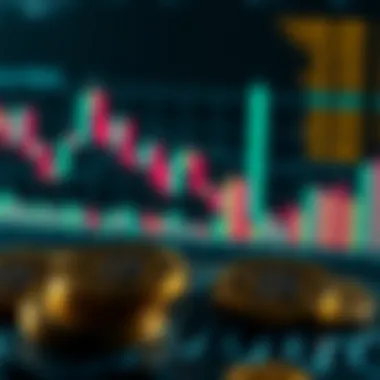Mastering Candlestick Analysis for Cryptocurrency Traders


Intro
In the realm of cryptocurrency trading, understanding the market dynamics is fundamental for making informed decisions. One of the most effective tools at a trader's disposal is the candlestick chart. Candlestick analysis provides insights into price movements and market sentiment, making it a crucial element of technical analysis. This article delves into the nuances of candlestick patterns and their implications for traders navigating the volatile waters of cryptocurrencies.
Setting the stage, we explore how mastering candlestick analysis can serve as a compass for traders. The rhythmic dance of candlesticks—each a representation of price action over time—offers clues about market psychology. For anyone serious about trading in cryptocurrencies, grasping these patterns can be the difference between profit and loss.
As we journey through this guide, readers will encounter a spectrum of patterns, strategies, and psychological insights that enhance trading decisions. Let’s begin our exploration by laying a solid groundwork of cryptocurrency fundamentals.
Understanding Candlestick Charts in Crypto Trading
Candlestick charts serve as a fundamental tool in cryptocurrency trading, providing investors a visual means to interpret market patterns and price movements. Understanding these charts isn't just a technical skill; it's a critical aspect of developing effective trading strategies. By recognizing the nuances of candlestick formations, traders can glean insights into market sentiment, making better-informed decisions.
What sets candlestick charts apart from traditional line charts is their ability to convey more information in a compact space. Each candlestick provides a snapshot of price action for a specific time frame, summarizing open, close, high, and low prices. This four-dimensional view allows traders to perceive both the overall trend and the volatility of an asset.
Benefits of Candlestick Analysis
- Enhanced Clarity: Candlestick patterns offer clarity into market movements. Unlike line charts that merely show a closing price, candlesticks encapsulate the range and volatility of price action.
- Signal Recognition: Observing distinct patterns can signal potential reversals or continuations, crucial for timing entries and exits. For instance, a bullish engulfing pattern may indicate a trend reversal, prompting a trader to consider a new position.
- Visual Insights: The color and shape of the candlesticks visually represent market psychology. A long green (or white) candlestick often indicates strong buying pressure, while a long red (or black) candle may show sellers taking control.
Understanding these aspects will allow you to navigate the often tumultuous waters of crypto trading more skillfully. By integrating candlestick analysis into your trading toolbox, you amplify your capacity to interpret market trends and make strategic decisions.
What Are Candlestick Charts?
Candlestick charts are visual representations of price movement over time, structured to provide traders with more in-depth information than traditional price graphs. Each candlestick reflects a specific time interval, such as one minute, one hour, or one day. Each "candle" typically has a body, which represents the opening and closing prices, and wicks, which show the high and low points during that time frame.
In the simplest terms, each candlestick can tell a story about market sentiment. For instance, when a candlestick has a large body and closes higher than it opened, it often signifies bullish sentiment. Conversely, if the body is small and the candle closes lower, it could indicate bearish sentiment.
Breakdown of a Candlestick
- Body: Represents the price range between open and close.
- Wick (or Shadow): Indicates price extremes during the period, showing high and low points.
- Color: Often filled or colored differently based on whether the closing price is above or below the opening price.
This dynamic charting method dates back to the 18th century in Japan and has found a significant place in modern trading, particularly in the volatile crypto markets.
Historical Context of Candlestick Analysis
The practice of analyzing candlestick charts originated in Japan over 200 years ago. By the 1700s, rice traders in Sakata developed this technique to track prices and trading volumes. They used a system that visually represented price movements to identify trends and patterns in the rice market.
As the years rolled by, Western traders and investors adopted candlestick analysis, expanding its use beyond rice to stocks and other commodities. By the late 20th century, candlestick analysis made its way into forex and cryptocurrencies, highlighting its resilience and adaptability across various financial markets.
Understanding the historical context enriches current candlestick analysis, imbuing it with a sense of tradition and time-tested strategies. This knowledge can enhance a trader's appreciation for the strategies they've inherited from generations of traders who came before them.
Why Candlesticks Matter in Crypto
Cryptocurrency markets are notorious for their volatility—prices can swing dramatically in minutes. In this landscape, having detailed visual tools like candlestick charts is not just useful; it’s essential.
Candlestick analysis matters in crypto for several reasons:
- Volatility Representation: Cryptocurrencies often experience extreme price fluctuations. Candlesticks accurately encapsulate these variations in a visually digestible format, informing traders when to act.
- Pattern Recognition: Recognizing candlestick patterns can help anticipate price prospects. Many traders find success from recognizing patterns like hammers, dojis, and engulfing patterns that hint at market behavior.
- Decision-Making: By allowing traders to visualize past price action, candlesticks help in making informed decisions. They provide insights into potential buy and sell signals, minimizing emotional biases that can influence decision-making under pressure.
In essence, mastering candlestick charts equips traders with the abilities to adapt to market dynamics and improve their trading performance. Understanding this tool paves the way for more strategic thinking, ultimately leading to smarter investments in the cryptocurrency realm.
Components of a Candlestick
Understanding the components of a candlestick is paramount for traders looking to navigate the ebb and flow of the cryptocurrency market effectively. Candlestick charts serve as a visual representation of market movements, summarizing essential details about price action over specific periods. By delving into the fundamental elements that make up a candlestick, one can extract invaluable insights that transcend mere price observation, leading to informed trading decisions.
Open, High, Low, Close Explained
At the heart of every candlestick lies four critical price points: open, high, low, and close, often abbreviated as OHLC. Each serves a distinct purpose and reveals a different aspect of market behavior.
- Open: This marks the price at which a particular time period begins. For instance, in a one-hour candlestick, the open price is the first price recorded within that hour. It sets the tone for market sentiment and often determines the initial direction.
- High: The peak price that an asset reaches during the time frame. It acts as the upper boundary, indicating the most optimistic market sentiment within that period.
- Low: Conversely, the low represents the lowest price during the same time frame. It reveals the least favorable market sentiment, showcasing the price floor for that period.
- Close: This is arguably the most critical point, marking where the price lands at the end of the time frame. Traders often consider the close as an important signal for future price movement, as it reflects buying and selling pressure at the end of the period.
Understanding these core components enables traders to gauge market sentiment effectively and make timely decisions based on real data.
Body and Wick: Understanding Size and Color


The body and wick of a candlestick provide insight into market dynamics. The body, which occupies the central portion of the candlestick, represents the price range between the open and close, while the wicks (or shadows) extend from the ends of the body to the high and low prices of the period.
- Body Size: A larger body indicates strong buying or selling pressure, suggesting that one side is dominant. A small body might point to indecision or a balance between buyers and sellers. Color also matters, where a green (or white) body usually indicates a close above the open price, signaling bullish sentiment, while a red (or black) body reflects a close below the open, hinting at bearish sentiment.
- Wick Length: Long wicks indicate volatility within the time frame. A long upper wick may suggest that buyers pushed the price up but were ultimately rejected, whereas a long lower wick reveals that sellers attempted to drive the price down but buyers stepped in to push it back up. Thus, the lengths and colors of these components can hint at potential reversals or continuations in market trends.
Interpreting Body Length and Wick Length
Analyzing the interplay between body length and wick length is crucial. Here are key interpretations:
- Long Body with Short Wicks: This often indicates strong momentum in one direction. For example, a long green body coupled with short wicks suggests that buyers were in control for the entire period, reflecting a decisive bullish trend.
- Short Body with Long Wicks: This configuration can signify market indecision. If both wicks are long, it often suggests that bulls and bears are struggling for control, and the market may be poised for a breakout.
- Wick-Heavy Candlesticks: A candlestick with a long wick and a short body could signify rejection of a price level, hinting at a potential reversal. Traders often look for these signs as indications of shifts in sentiment.
By looking closely at these components, traders can gain a richer understanding of price action and adjust their strategies accordingly, whether it's entering a position or setting stop-loss orders. Thus, mastering these basic elements can be instrumental in one's trading prowess, leading to clearer insights and enhanced opportunities in the volatile world of cryptocurrency.
Key Candlestick Patterns and Their Significance
Understanding candlestick patterns is like holding the keys to a treasure chest in cryptocurrency trading. These patterns allow traders to decipher the underlying market sentiment and establish educated trading strategies. They serve as visual clues, revealing potential bullish or bearish reversals in price action. By analyzing candlestick formations, traders can enhance their decision-making, aligning their trades with the broader market strategies. In this section, we will explore a range of candlestick patterns, categorizing them into single, double, and three-candlestick formations, and discuss what they mean for a trader looking to navigate the volatile waters of cryptocurrency markets.
Single Candlestick Patterns
Doji
The Doji pattern can be seen as a stalemate, where neither buyers nor sellers gain a definitive edge. Its defining characteristic is that the opening and closing prices are almost identical, resulting in a small body with extended wicks. This signifies uncertainty and indecision in the market. Traders often view a Doji as a potential signal that a trend could be reversing soon. It’s a popular choice for traders due to its straightforward nature and its ability to indicate potential turning points. However, relying solely on this pattern can be a double-edged sword since it does not indicate the direction of the next move.
Hammer
The Hammer pattern is a classic signal of a potential bullish reversal, typically found in a downtrend. Its distinctive feature is a small body at the top with a long lower wick, which suggests that buyers pushed the price up after a period of selling. This pattern informs traders that buyers are starting to gain influence. Due to its reliable nature when confirmed by subsequent price action, the Hammer is a favorite among traders. Yet, traders must tread carefully, as the presence of false signals can lead to misguided trades.
Spinning Top
The Spinning Top pattern embodies indecision, much like the Doji. It features a small body with long wicks on either side, indicating that the market is swinging both ways. This pattern often appears during consolidation periods and suggests that buyers and sellers are battling it out without a clear victor. Traders find value in the Spinning Top as it can foreshadow potential trend reversals, but, similarly to the Doji, it requires additional confirmation from other signals to strengthen its predictive validity.
Double Candlestick Patterns
Engulfing Patterns
The Engulfing Pattern is a wonderful representation of market sentiment shifts—when a small candlestick is followed by a larger one that completely encompasses it. The bullish Engulfing pattern, found in downtrends, reveals that buyers have overtaken sellers. Conversely, a bearish Engulfing indicates a shift in power from buyers to sellers in an uptrend. Traders appreciate these patterns for their strength in signaling potential reversals. Nevertheless, context and subsequent confirmation (often through additional technical indicators) should be employed to maximize trading efficacy.
Harami Patterns
The Harami pattern, consisting of a large candle followed by a smaller candle that fits within its body, symbolizes the market’s indecision and potential for change. A bullish Harami occurs in a downtrend and hints that upward momentum may be taking hold, while a bearish Harami in an uptrend suggests the possibility of a downward shift. This pattern can be quite effective, but lay caution—like other patterns, the Harami should be seen in conjunction with other analysis methods to avoid misinterpretations.
Three Candlestick Patterns
Morning Star
The Morning Star pattern consists of three candles: a bearish candle followed by a small-bodied candle that indicates indecision, and closing with a bullish candle. This pattern often signals the end of a bearish trend and suggests that buyers are gaining strength. The Morning Star is advantageous for traders as it conveys a decisive shift from selling to buying. However, as with any pattern, market context should be taken into account when making trading decisions.
Evening Star
The Evening Star pattern is the inverse of the Morning Star. It highlights a transition from a bullish trend to a bearish one. Its formation involves a strong bullish candle, a small-bodied candlestick, and a bearish candle that closes below the midpoint of the first candle. This pattern serves as a warning for traders that the upward momentum may be fading. Proper interpretation of the Evening Star is vital since it can offer substantial risk if misread, as false signals can also occur.
Three White Soldiers
The Three White Soldiers pattern manifests as three consecutive bullish candles, each closing higher than the previous one, typically occurring after a period of decline. It signifies significant buyer strength and confidence in an upward price movement. Traders often view this pattern favorably and see it as an opportunity for long positions. Nevertheless, confirmation from volume and other market indicators should be demanded to reinforce the validity of this signal.
"Identifying these key candlestick patterns can significantly enhance a trader's strategic insight and market awareness."
In summary, comprehending these candlestick patterns allows traders to glean vital insights into market dynamics and make more assured trading choices. These patterns are foundational in the toolkit of anyone serious about navigating cryptocurrency markets.
Utilizing Candlesticks in Trading Strategies
When navigating the unpredictable tides of cryptocurrency trading, blending candlestick analysis with structured strategies can be a game changer. Candlestick patterns are not just pretty pictures; they provide insights into market sentiment and potential price movements. By mastering how to incorporate these patterns into trading strategies, traders can develop a more informed approach to buying and selling.
Incorporating Candlesticks with Other Indicators
Moving Averages


Moving averages are like the bread and butter of trading indicators. They smooth out price data, allowing traders to see trends more clearly over time. When traders combine moving averages with candlestick analysis, they can spot signals that might not be plain as day at first glance. For instance, when a candlestick pattern appears near a moving average line, it could suggest that the price is finding support or resistance around that level.
A key characteristic of moving averages is their lagging nature; they respond to price changes but do so with a delay. This can actually work to a trader’s advantage, as it helps in identifying more reliable trends rather than transient price fluctuations. However, this delay also means that if the market is moving fast, the signals might not always capture the moment you want to act.
RSI and Candlestick Analysis
The Relative Strength Index (RSI) is a momentum oscillator that measures the speed and change of price movements. It oscillates between 0 and 100, providing insights into whether an asset is overbought or oversold. Integrating RSI with candlestick analysis offers traders an additional layer of confirmation. When a candlestick pattern, like a doji, appears along with an RSI indicating overbought conditions, it might signal that a reversal is around the corner.
A unique feature of RSI is its ability to reflect market momentum, which can often diverge from price trends. For example, one could see prices rising while RSI starts to decline—a red flag that suggests caution. This divergence can signal potential trend reversals and is crucial in a trader’s decision-making process.
Risk Management through Candlestick Patterns
Risk management is paramount in any trading strategy, but utilizing candlestick patterns adds a distinct flavor to it. By recognizing certain candle formations, traders can set stop-loss orders more strategically. For example, if a trader identifies a shooting star pattern after a bullish rally, it might prompt them to sell or tighten their stop-loss.
Understanding the market psychology behind these patterns can help traders manage their risks better. A single candlestick can narrate a story of buyer exhaustion or sudden seller pressure, allowing for timely decisions that can minimize losses.
Setting Entry and Exit Points
Setting entry and exit points is often where many traders falter. Candlestick patterns are invaluable in providing potential entry and exit signals. For instance, if there’s a bullish engulfing pattern at a support level, that might just be the greenlight a trader has been waiting for. Conversely, if a strong bearish pattern forms near resistance, it signals a prudent moment to exit or short sell.
Effective entry and exit strategies depend not only on recognizing these patterns but also on understanding their implications in the broader market context. A careful analysis of candlesticks alongside economic news can yield more robust trading decisions.
In summary, integrating candlestick analysis into trading strategies enables traders to capture unique insights, set informed risk levels, and optimize their trading timing. For those willing to roll up their sleeves and delve deep, candlesticks can provide a rich resource of information that is essential in the dynamic and ever-evolving world of cryptocurrency.
Psychological Factors in Candlestick Trading
When it comes to trading cryptocurrencies, the psychological factors can play a role just as large as technical indicators. Understanding these nuances can lead to more informed decisions and better trading outcomes. Traders are often influenced by emotions such as fear, greed, and impatience, which can blur analytical judgment. Thus, grasping how these psychological elements interact with candlestick patterns is crucial for developing a robust trading strategy.
Market Sentiment and Candlesticks
The pulse of the market can often be gauged through candlestick charts. Each candlestick reflects not just numerical data, but also the collective sentiment of every trader who has participated in that trading period. Bullish (rising) candles signal confidence and optimism among traders, whereas bearish (falling) candles can indicate anxiety or fear. This sentiment can create trends, and awareness of it makes a world of difference.
Consider, for example, when a new cryptocurrency launches and the initial waves of trading produce exaggerated price movements due to speculative enthusiasm; the candlesticks during this period will reflect that extreme sentiment. Conversely, a prolonged decline in value often leads to a bearish sentiment that can create further panic-selling, as seen in summer 2022’s market downturn.
At times, it's worthwhile to stand back and look beyond the numbers. Being aware when market sentiment shifts can preempt costly mistakes. For instance, when a major crypto exchange announces critical changes, candlestick patterns may shift quickly, sometimes before news in traditional channels becomes widespread. Assessing the emotional undercurrents can provide a tactical edge that goes beyond mere pattern recognition.
Understanding Trader Psychology
The psychology of traders is like the wind—sometimes unpredictable and often underestimated. Many traders fall into the classic trap of overreacting to losses or gains, which can lead to emotional decision-making rather than using rational analysis. This behavior is often amplified in the volatile landscape of cryptocurrencies, where price swings can be dramatic, leaving traders rattled.
Recognizing the psychological pitfalls can be essential. Hasty decisions often lead to placing trades based on impulse rather than sound analysis. For example, a trader might experience exhilaration after a profitable trade and feel invincible, prompting them to take on riskier positions. Conversely, a series of losses may create a sense of hopelessness, leading to withdrawal from trading altogether.
One useful strategy to mitigate the adverse effects of emotional trading is cultivating a disciplined mindset. Here’s how:
- Set clear goals: Define what success looks like for each trade—this might mean a specific profit target or a fixed stop-loss.
- Stick to a plan: Develop a comprehensive trading plan that incorporates your assessments of candlestick patterns, market sentiment, and risk tolerance.
- Reflection: After important trades, take time to reflect on how emotional factors influenced decisions. This reflection can yield insights for future trades.
Understanding both the market sentiment reflected in candlestick patterns and the psychological influences on trader behavior provides a dual-pronged approach to boosting your effectiveness in trading cryptocurrencies. The reality is that, in an industry characterized by rapid changes and widespread uncertainty, having a mercurial mindset can often undermine the most carefully laid strategies. Therefore, a balance must be struck between technical acuity and the mental discipline that governs successful trading practices.
"Emotional intelligence in trading is as essential as the technical know-how."
As you delve deeper into candlestick analysis, keep an eye on these psychological factors as they will not only help in navigating the complexities of the market but also enhance your trading prowess in this fast-paced environment.
For further insights on behavioral finance and trading psychology, check out resources from reputable sources like Investopedia or CFA Institute.
Common Mistakes in Reading Candlesticks
Understanding the common mistakes in reading candlesticks is crucial for traders and investors aiming to improve their skills. Candlestick analysis is not just about recognizing patterns; it’s also about understanding how market dynamics and trader psychology interplay with these patterns. Misinterpreting candlestick signals can lead to poor trading decisions, resulting in losses.
Being aware of these common pitfalls can significantly enhance your trading strategies. Below we’ll delve into two key mistakes that many traders make — overanalyzing patterns and ignoring market context.
Overanalyzing Patterns
One of the biggest traps traders fall into is overanalyzing candlestick patterns. It’s quite tempting to dissect every tiny detail, trying to find meaning in every flicker or shape on the chart. While it’s essential to understand the nuances of candlestick formations, there’s a fine line between thorough analysis and excessive scrutiny. Overanalysis can breed confusion and uncertainty. Traders may hesitate too much, second-guessing their decisions, leading to missed opportunities.


For example, if a trader sees a Doji candlestick, they might spend too much time pondering whether it indicates a reversal or stagnation. Instead, they should consider the overall trend, the preceding candlestick patterns, and the broader market context. A good practice is to focus on prominent patterns and let them guide your strategy without getting bogged down by every single detail.
- Key Points to Avoid Overanalyzing:
- Stick to well-known patterns instead of obscure variations.
- Use other technical indicators to complement your analysis.
- Trust your research and instinct while being open to reevaluation.
"Analysis paralysis can paralyze your trading and leave you out in the cold."
Ignoring Market Context
Ignoring the market context when interpreting candlestick patterns is another misconception that can lead to financial mishaps. Candlestick patterns don’t operate in a vacuum. They are extremely influenced by factors such as market news, global events, and general trader sentiment. Just because a bearish engulfing pattern appears does not mean a market decline is imminent. The overall trend, volume, and the sentiment prevailing in the market play crucial roles.
Suppose news breaks about regulatory changes affecting a specific cryptocurrency. If a trader solely relies on candlestick analysis without absorbing this context, they may misinterpret bullish signals as a confirmation of a market entry point, ignoring the potential for volatility based on external factors.
- Considerations for Market Context:
- Stay updated on news that could affect market sentiment.
- Analyze trends in conjunction with macroeconomic indicators.
- Understand seasonal and cyclical behaviors in crypto trading.
By incorporating context into your candlestick analysis, you can avoid these common errors, giving you a more rounded understanding of market movements. Mastering both the patterns and the surrounding circumstances will empower your trading decisions.
Practical Tips for Effective Candlestick Analysis
When delving into the complexities of candlestick analysis in the context of cryptocurrency trading, it's crucial to have practical strategies to support your understanding and application. Candlestick patterns can be strikingly instructive, yet the real power originates from consistent practice and the use of appropriate tools. Here, we'll discuss the importance of practical tips in honing your candlestick skills, as well as the specific elements you can employ to sharpen your trading acumen.
Practicing with Live Charts
One of the most effective ways to master candlestick patterns is to spend time practicing with live charts. While historical data can teach you how to recognize specific formations, live charts allow you to observe how prices respond in real-time.
- Choose an online trading platform: Look for platforms that offer real-time candlestick charting. Popular choices include Binance, Coinbase Pro, or TradingView. These platforms are not only user-friendly but also provide advanced features that cater to both novice and experienced traders.
- Set alerts: Most platforms allow you to set price alerts based on certain candlestick patterns. This feature helps you stay informed and act promptly when potential trading opportunities arise.
- Review market trends: Make it a habit to analyze market trends in conjunction with candlestick patterns. Observing how various cryptocurrencies react during different market conditions enhances your ability to forecast price movements.
Practicing with live charts is akin to training for a sports competition; it helps you develop a sixth sense for price action, improving your speed and accuracy in decision-making.
Using Candlestick Analysis Tools
In addition to live practice, employing analysis tools can significantly enhance your candlestick skills. There are several tools available that not only streamline the process of identifying patterns but can also provide deeper insights into market behaviors.
- Technical indicators: Tools like Moving Averages and the Relative Strength Index (RSI) can be integrated with your candlestick analysis to forestall false signals. For instance, if a bullish engulfing candlestick appears while the RSI indicates overbought conditions, it might be prudent to wait before entering a trade.
- Pattern recognition software: Automatic pattern recognition tools scan charts to help identify formations, so you can focus on strategizing rather than pattern recognition. Products such as TrendSpider or CryptoView offer features that can assist in swift analysis.
- Backtesting tools: Platforms like Coinigy allow you to backtest strategies based on historical candlestick formations. This not only helps you validate your trading strategy but also aids in adjusting it according to past performance.
Incorporating these tools into your trading regimen lets you make well-informed decisions rather than flying blind based on instinct alone.
"The key to successful trading is patience and discipline, coupled with a solid understanding of market indicators, including candlestick patterns."
By utilizing live charts and analysis tools effectively, you will forge a solid foundation in candlestick analysis, leading you toward more astute trading decisions in the vibrant domain of cryptocurrency.
The Future of Candlestick Analysis in Crypto Trading
As we forge ahead in the world of cryptocurrency, the relevance of candlestick analysis remains an integral piece of the puzzle for traders and investors alike. Understanding future trends will not only enhance your knowledge but also improve decision-making in an environment that fluctuates as quickly as a rollercoaster ride. Candlesticks provide a layer of insight that can be crucial as technology evolves and trading methodologies shift.
Emerging Technologies and Their Impact
The landscape of trading is rapidly changing due to the influx of emerging technologies. Innovations such as blockchain enhancements and algorithmic trading have made vast inroads into how traders analyze market conditions. For instance, many platforms now utilize real-time data analytics, which allows traders to observe candlestick patterns as they form. This immediate feedback can assist in refining trading strategies, making them more agile than ever before.
Moreover, developments in machine learning have the potential to transform how candlestick patterns are interpreted. Algorithms can sift through vast amounts of historical data to identify trends and anomalies that a human eye might miss. As a result, patterns that might take hours to discern can now be highlighted in an instant, making decision-making swift and more informed.
- Key elements to consider:
- Enhanced speed and accuracy in data analysis.
- The ability to backtest strategies using historical data tailored to specific candlestick configurations.
- Improved pattern recognition facilitated by AI-driven tools.
The integration of these technologies signifies that traders must stay vigilant and adaptable. Understanding this evolution will be crucial to remaining ahead of the game. Only those who can effectively leverage these tools will truly experience the benefits in their trading journey.
Integrating AI with Candlestick Patterns
Artificial Intelligence (AI) is not just a buzzword; it's reshaping the very foundations of trading strategies, especially concerning candlestick analysis. Several platforms now employ AI to analyze patterns and even predict future market movements based on historical data. By integrating AI, traders can gain access to advanced predictive models that sift through candlestick data to identify potential opportunities for profit.
- Benefits of AI integration:
- Predictive analytics: AI can predict price movements with a remarkable degree of accuracy by recognizing underlying trends from candlestick patterns.
- Automated trading: Traders can set AI-based systems to execute trades automatically when specific candlestick formations appear.
- Customization: Different traders can tailor AI systems to fit their unique trading styles and preferences, allowing for a more personalized approach.
AI does not only enhance the accuracy of candlestick analysis but also removes much of the emotional bias that can cloud judgment during trading sessions. The tools powered by AI are designed to remain unbiased, using algorithms to make decisions solely based on data. This not only helps in maintaining discipline but also provides a competitive edge in trading,
As the crypto market continues to mature, those who embrace these technologies will likely find themselves at the forefront of trading innovation. Thus, constantly seeking knowledge on how to implement and optimize these advancements in candlestick methodologies will lead to greater success in a field that is anything but predictable.



